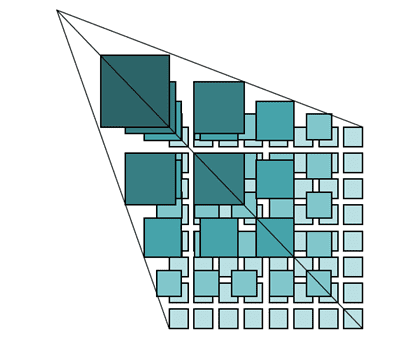Map tile is a new technology that can divide map data into a set of squared
tiles in multiple formats and storage types, which can significantly improve
the efficiency of accessing online maps. SuperMap iDesktop supports two kinds
of tiles including traditional raster tiles and vector tiles.
Raster Tiles
Traditionally, raster tiles technology was used for web maps. In essence, raster tiles are squared pictures usually ordered in the pyramidal scheme. Each tile has a fixed geographic area and scale. They are created from spatial data (raster or vector data) and saved in a disk or database. Combining them can get a whole map.
With the development of Web GIS, the user has higher and higher requirements to map display and transmission. The raster tiles technology significantly speeds up the map browse, which reduces the server and bandwidth consumption greatly. Currently, a lot of online map applications (Baidu Map, for example) adopt the technology to load base maps.
On the generation of map tiles, please refer to Generate Map Tiles.
Vector Tiles
Raster Tiles technology popularizes web maps. But the raster tiles size is still big. Generating raster tiles is very time-consuming. Thus, the vector tile technology is introduced. It divides vector layers into squared tiles.
Vector tiles are applicable for realtime data rendering (POI and roads, for example). Besides, vector tiles can be accessed offline on mobile devices, which improves the efficiency of map browse.
Moreover, vector tiles are rendered on the client-side with a style file that defines map elements look. And so, when there are some changes in map styles, for raster styles, we have to generate all raster tiles again. But for vector tiles, we can modify the style file to modify tile styles easily.
On the generation of map tiles, please refer to Vector Tiles.
Contrast between raster tiles and vector tiles
We compare and contrast vector tiles and raster tiles from 9 aspects shown below. According to the result, you can select a proper tile type.
- Tile size : Vector tiles are up to thousands of times less in file size than equivalent raster tiles and lower bandwidth consumption. They make access to maps offline possible.
- Generating time : Generating vector tiles takes a shorter time.
- Tile update : When map stiles change, for raster tiles, we have to generate tiles again. While for vector tiles, all we need is to update the style file.
- Style modification : We can separately change the vector tiles style, but not the raster tiles style.
The raster tiles technology is a mature technology that has been developing for a long time. Therefore, raster tiles have been widely used on web map services. While the vector tiles technology is new, it still has some shortcomings. For example, the display of a map on an application may be different from on a browser.
| Items | Vector Tile | Raster Tile |
|---|---|---|
| Tile Size | small | large |
| Generating time | slow | faster |
| Update tile | Style and tiles are separate. supports updating them independently | Generate tiles again |
| Style Modification | Supports | Doesn’t support |
| Technical requirement to the front end | High (HTML5) | Low |
| Display Difference | Has dispaly differences | The same |
| Maturity | Ordinary | High |
| Application | Specific (mobile device, style modification) | Widely used |
